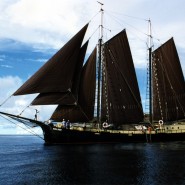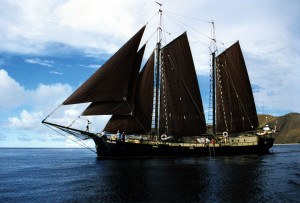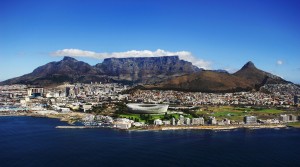The Crew Ship

Adventure on the high seas need not be the exclusive domain of sea-faring souls; even sea-fearing landlubbers can set sail and prove their sea worthiness by crewing on a private boat.
First and foremost, let me clarify, I am not a sailor.
I knew nothing of boats and even less about sails, but none of this stopped me from successfully crewing aboard a sailboat from Fiji to New Zealand.
It was while backpacking through Fiji’s capital Suva that I came across a youth hostel notice seeking sailing crew in exchange for passage across the South Pacific to New Zealand. Despite having an airline ticket to Auckland I was intrigued by the prospect so I applied.
 Any hesitations I had about my complete lack of sea-faring experience were cast away the moment I saw the boat moored in the harbour. Christened “The Adelaar” it was closer in appearance to a tall ship than the yacht I had anticipated. The double masted schooner was approximately 110 feet long. Its iron hull dated back to the early 1900s and was covered by a wooden deck. Portholes punctuating the hull provided a salt stained glimpse into an interior containing four private bedrooms, a large kitchen and a cosy communal room with comfortable looking oversized lounges.
Any hesitations I had about my complete lack of sea-faring experience were cast away the moment I saw the boat moored in the harbour. Christened “The Adelaar” it was closer in appearance to a tall ship than the yacht I had anticipated. The double masted schooner was approximately 110 feet long. Its iron hull dated back to the early 1900s and was covered by a wooden deck. Portholes punctuating the hull provided a salt stained glimpse into an interior containing four private bedrooms, a large kitchen and a cosy communal room with comfortable looking oversized lounges.
Onboard, I met the captain and his wife. A Swiss couple who, after more than a decade of sailing, were on their way to settle in New Zealand for the sake of their two ocean-raised children approaching school age. This was to be their last voyage.
I passed what limited questions were asked of me. Had I sailed before? “No.” Did I get seasick? “Don’t know, never sailed before.” Could I cook? “Not if my life depended on it!”.
That settled, I was invited to join the crew and for the ten day privilege of passage was asked to part with a small sum to cover food and lodging. Initially, my land-lock mind objected to having to pay to work, but apparently this agreement is quite standard between crew and captain. I was working for my passage only and couldn’t expect the captain to supplement my voracious appetite.
But the truth was I was hooked the moment I set foot aboard this classic vessel. To me the idea of sailing across the South Pacific embodied a romantic age of exploration. Even if I had to wash dishes and peel potatoes to supplement my travel, I wanted this experience.
Sharing this working holiday, my fellow crewmembers included two Canadians; an American university student; a British backpacker, a couple from Norway, and the youngest, a 19 year old Kiwi.
Our excitement on the first day aboard was palpable. Among the eight interns – six boys, two girls – only the Kiwi had any previous sailing experience. The rest of us were amateurs – and treated as such by the captain.
Like kids set loose on a new playground, we spent our first hours climbing the ship’s masts and exploring its every nook and cranny. Reigned in by the captain we were given knot tying lessons, familiarised with the boat’s working parts and instructed about ship safety – or it seemed, lack thereof.
When someone sensibly inquired about using harnesses to secure us to the boat, the captain told us there were no harnesses. Nervous novices we pressed the issue further: What happens if one of us should fall over board?
His patience tried, the captain curtly replied that if we were lucky enough to see someone fall overboard, we were to release a flag bearing buoy into the water to mark the spot of the man overboard. But, he said, by the time the ship could navigate a full circle even the flagged buoy would be hard to find much less the lost soul. I can’t be certain but I’m sure he mumbled something like, “So we won’t bother”. Comforting.
He continued the safety tour by pointing to two fiberglass encased life rafts perched atop the wheelhouse. ”The smaller life raft costs $5,000, the larger one $8,000 – so don’t use them!”, he scowled. And with that he was off to consult his charts. The tone of the trip was set.
With two sick children to care for the captain’s wife was not accompanying us on the voyage – instead she would fly to New Zealand with the children and await our arrival.
Finally the time came to set sail. The anchor lifted? The main sail up? The sheet secured? The first, second and third bow sails raised? The mission sail hoisted? Aye aye Captain! Then Mother Nature gently blew us a kiss that filled the sails. They embraced the affection and we were on our way. Sailing at a speed of six knots/hour we headed out of the sheltered harbour and into the open sea.
I slipped into the ship’s hammock while the sunset painted the sky. On the starboard reds, yellows, and oranges burned into the clouds, while to the port, blues, greens, and purples subdued the fiery firmament. As I lay there, the sea’s swell taking the effort out of rocking the hammock myself, I waved good bye to the cape of Kondavu – the last bit of land I was to see for some time. Could life be anymore poetic?
But this was not a cruise ship, but a crew ship. There was work to be done. As crew, we were to consistently man the deck using a rotating eight-hour roster that paired people together for three two-hour shifts with a six-hour break in between. But as I was to learn nightly the work didn’t stop there. Even if I had just completed my shift and was drifting off to sleep, it did not exclude me from midnight calls to deck to be one of the four men regularly needed to adjust the sails.
While the actual steering was left to an autopilot repeatedly programmed by the captain, it was our responsibility to ensure the boat stayed on course. We were also on the look out for changes in the wind’s direction to ensure the boat maintained speed.
At night, when our frugal captain felt it best to conserve energy and sail without lights, we had to be especially diligent in watching for the lights of other ships that wouldn’t see us. We never hit anything, nor did we come close, but at the back of my mind during the entire trip was the thought that we might come across another unlit ship captained by an equally thrifty individual as our own and then ……
Life was idealic for the first couple of days, my watches were uneventful allowing me time to postulate about which ancient seafaring explorer’s wake I was following. I marveled at the breadth of the ocean, which stretched out to the horizon in all directions, making it easy to believe the world was flat and we were the centre of the universe.
Meals were made in rounds by the different watch teams. With such culinary cultural diversity amongst the crew we were treated to everything from a Nordic fish soup, freshly caught, to Tex-mex vegetarian. And with every meal, warm ship-baked bread.
On the afternoon of our second day at sea, the captain emerged from the bowels of the ship to break everyone’s resort-like reverie. We were to face the challenges of an impending storm. It was to hit either later that evening or the next morning. All hands were on deck as we were rushed through emergency procedures. We were taught how to tighten sails in high winds and shown how to reef in a portion of the sail so that wilder winds would still work to our advantage without overpowering us.
By dinner the weather started to change. Our meal was interrupted as we were called to reef in one of the sails and let the boom out. Twice more during the night I was woken to assist on deck as the storm moved closer.
By the morning the storm had hit. Sleep deprived from a night of crewing I woke to a violently tossing ship as seven metre high waves played carelessly with our vessel. The excessive length of the Adelaar made it awkward to ride up one wave and down the other. Instead, the ship was forced to bridge two waves at once – often unsuccessfully – as the bow came crashing down into the second wave’s trough with a boat-shaking thud, or alternatively, was propelled through the second wave as the ship continued its journey down the first. Either way, water washed onto the deck in great swells as Poseidon’s giant hands reached from the depths to claim us for his own, only to relinquish his grip at the last moment.
One night, perhaps the scariest during our adventure in the storm, I was called to deck along with the rest of the crew for one of our midnight maneuvers. I was told by the captain to climb atop the wheelhouse to move the preventor rope from the ship’s starboard to its port. The rope had to be secured before the boom could be swung across to the other side or we ran the risk of the boom swinging out too wide when we tacked directions.
While the roof of the wheelhouse was a textured metal for added grip, in the slippery rain it did little to inspire confidence.
Crouched atop the roof, with nothing connecting me to the ship, I did my best Spiderman impersonation. The pitch and roll of the boat, combined with the roof’s angle, had me looking directly over the deck’s railing and into a watery grave below. I clambered across the wheelhouse passing the rope from one side to the other while my fellow crewmembers struggled to turn the ship around. Flattening myself against the wet roof, the main boom swung over top of me literally inches above my body.
In that moment time stood still. High up on the 30 metre masts four lamps enveloped the ship in light, creating a distinctive line between our own little world and the darkness beyond. I remember thinking at the time that this is what it must be like to be trapped in a crystal ball as Greek Gods gaze down and debate your fate amongst each other.
It seems they were on my side. I was allowed to escaped death’s slobbery maw.
The days during the storm became a blur. But I clearly remember twice looking to the moody sky and thinking about the airline ticket I had sacrificed for this escapade when I could have been in New Zealand after just a six-hour flight.
When the storm abated three days later, it had left its mark. Of our nine crewmembers, five were bed-ridden with sea-sickness – one of them was the captain! He still managed to crawl to the deck occasionally to re-set the autopilot and vomit over the side before descending into the ship’s depths to be tossed and turned some more.
Amazingly, I was not sick. I don’t deny having a couple of very close calls – I felt particularly green most of the time – but I can proudly say a bland diet of mash potatoes helped me withstand the challenge.
With the bed-ridden unable to take their shifts, it was decided between the four remaining – the two girls, the Kiwi and myself – to divide the watch into two-hour single man shifts.
And so it was at 2am that night, I found myself performing a solitary watch while the rest of the ship slept. Dressed in warm layers and coated in wet weather gear, I stood at the back of the boat and communed with the mighty sea one on one. And it was frightening…
The ocean was still incredibly rough. Every time the bow crashed through a wave it picked up a cargo of water that raced down the side decks to swirl around my knees before draining off the stern. I worried whether the next wave would be large enough to wash me overboard.
I was also spooked by the idea that I was the only conscious creature as far as the eye could see. It drove home the responsibility resting on my shoulders for the ship’s safety and the welfare of those she held cocooned. And for some reason, I thought of ghosts.
They say an idle mind wanders, so in the middle of the night, in the middle of the ocean, unbeknownst to the crew below I chased away the sea-bound souls and the great ship’s ghosts by plugging into my music and dancing around the deck.
One of the funniest things to happen during the voyage was when the small life raft came flying off the wheelhouse and landed in the ocean. The three of us nearby raced to retrieve it by its ship-attached line. As we struggled to haul it in, its fiberglass canister broke open and the life raft inflated. Even so, the three of us managed to pull it alongside the boat before it filled with water and had to be cut loose. Nobody but the captain was particularly upset, because we couldn’t mourn something that was never ours. I thought I heard someone mumble, “Serves him right”, but I can’t be sure.
By day seven, the sea started to calm down and the ship slowly came back to life. Portholes were safely opened, allowing fresh air to stream into the boat’s belly and force the stale sick smell out. Dirty dishes that had accumulated during the storm were finally attacked and put away.
An albatross, with its massive wings gliding gracefully over the ocean currents, came to greet us as a goodwill ambassador.
Reasserting our control over the ship, we set about raising all her sails. I had the exhilarating pleasure of hoisting the bow sails.
Wearing waterproof overalls, I climbed into the net strung between the boat’s bow and the extending boom pole. Suspended above the water, as I went about releasing the tied sails, the ship’s bow regularly dipped into the oncoming waves and I went along for the ride of my life. The experience was akin to being dropped into the dunking tank at a local fete, but far more fun. No sooner was I submerged in the ocean up to my chest than the ship rode to the top of the next wave and I was ripped from the water to swing five metres above the swell.
Our final two days at sea were picture perfect if not a little boring. The glassy sea was as still and as serene as a Swiss Lake. (Something I would never have believed until I saw it with my own eyes.) The sun was shining strong in a bluer than blue sky. Everyone was outside and no one was worried about shifts. The stereo speakers were put on deck and in our own private amphitheater we turned the music up loud. And the albatross, enjoying our company, had taken up residence on the stern’s currents.
In retrospect, the days during the storm had provided such an adrenaline rush that straight sailing paled slightly in comparison. Cabin fever had also set in. Even with 110 feet of ship, finding personal space was a challenge after nine days of living in closed quarters.
I busied myself by sewing sails damaged during the storm and even made an attempt at steering. My first endeavour navigating failed miserably when I somehow managed to turn the ship around 180 degrees in less than half an hour. The shifting sunlight in his cabin aroused an angry captain who raced from below to relieve me of my post.
As promised on the tenth day we reached New Zealand. Dolphins leapt through the bow spray to greet us and to the starboard, the welcome sight of the country’s lush, green coastline. After ten days on the open sea, with an unfettered view to the horizon, it felt almost claustrophobic to be so close to land.
Pulling into dock, we worked like a finely tuned instrument. Each of us knowing what to do after more than a week’s experience crewing, compared to the notes we first played.
When it comes to nautical know-how, despite sailing ten days across the South Pacific, I would still hesitate to qualify myself as being worth my weight in sea salt. During the entire ten days at sea we never saw another soul, another ship on the horizon or a piece of land between Fiji and New Zealand. Despite having the company of eight others it was a very solitary experience. Sleepless nights, hard work, sea sickness ……
But crazy as it sounds, given the opportunity, I would do the whole trip again for the experience has only served to whet my appetite.
(Footnote: The Adelaar is still alive and well cruising around Indonesia with a new owner and offering sailing expeditions.)





Your adventure piece “The Crew Ship” may just inspire us would-be sailors to leave sooner, travel farther, and enjoy life more fully (and carry a barf bag in our back pockets). Enjoyed the read. Well written. Almost as amazing as the story though, is that you guys reconnected after almost twenty years. It appears that both experience junkies are still in hot pursuit of adventures! Cheers Michael.